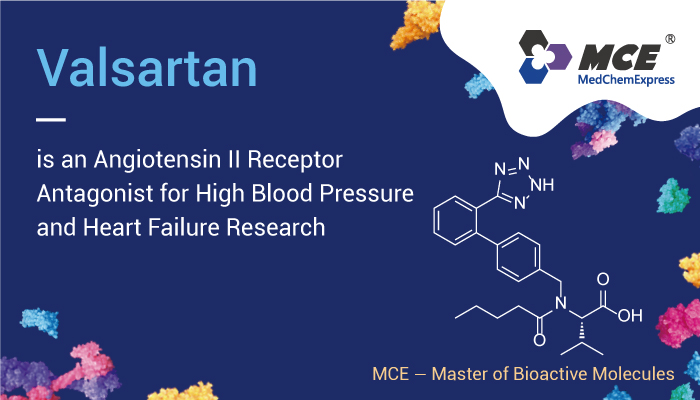Angiotensin receptors are a class of G protein-coupled receptors with angiotensin II as their ligands. And angiotensin receptors and angiotensin II are important in the renin-angiotensin system. Noticeably, they are responsible for the signal transduction of the vasoconstricting stimulus of angiotensin II. Therefore, angiotensin receptors and angiotensin II play a critical role in cardiovascular disease such as high blood pressure and heart failure. Furthermore, Valsartan (CGP 48933) is a selective angiotensin II type 1 receptor (AT1R) antagonist, and has been approved for the treatment of hypertension. Besides, Valsartan is also used for research of other cardiovascular diseases such as endothelial dysfunction and heart failure.
Valsartan, a selective angiotensin II type 1 receptor (AT1R) antagonist, can be used for cardiovascular diseases research.
In vitro, Valsartan (1 μM, 48 h) reverses ageing-induced changes in Bcl-2 and Bax in aorta endothelial cells from adult rats. Simultaneously, Valsartan also decreases the elevated expression of AT1R and p-ERK. Inaddition, Valsartan reduces the accumulated expression of TFG-β/Smad, Hif-1α and collagen in hypoxia cardiac cells. Therefore, Valsartan has great potential cardioprotective effect.
In vivo, Valsartan (30 mg/kg in their drinking water, daily for 6 months) protects vessels from ageing-induced injury in a rat model of normal ageing. Besides, it prevents the development of aorta ageing in this model. Valsartan (3 mg/kg/day, i.v., daily for 1 week) shows protective effects on cardiac function in rats with myocardial infarction. Specifically, Valsartan inhibits the expression of TGF-β/Smad, Hif-1α and fibrosis-related protein in the border of the infarcted zone.
In conclusion, Valsartan is a selective angiotensin II type 1 receptor (AT1R) antagonist, and can be used for cardiovascular diseases research.
References:
[1] HaiYan Shan, et al. J Cell Mol Med. 2014 Jun;18(6):1071-80.
[2] Sui X, et al. J Cell Mol Med. 2015 Aug;19(8):1773-82.
